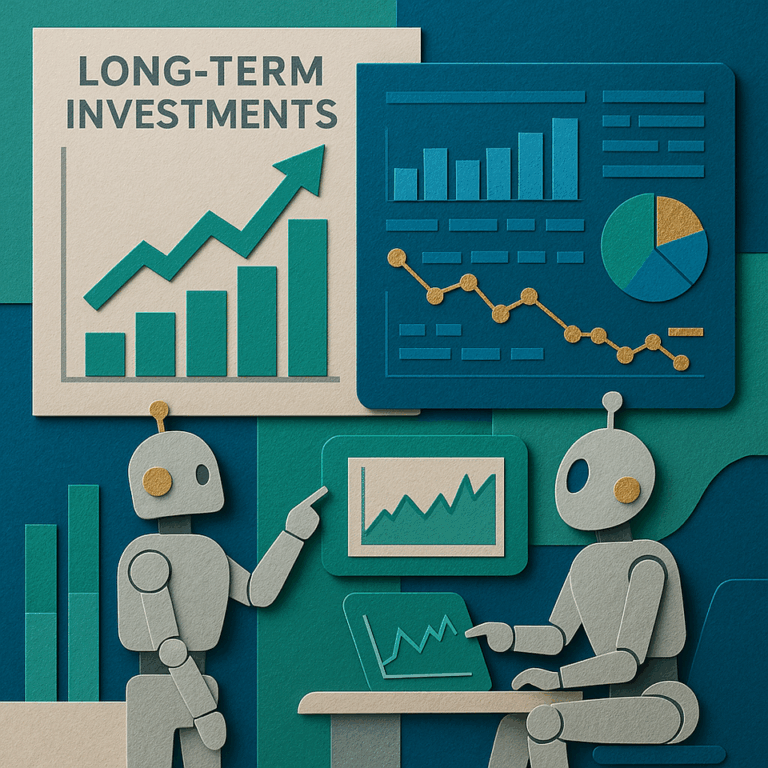Introduction: The Impact of AI Long-Term Investment Strategies on Financial Planning
AI long-term investment strategies have rapidly become a transformative force in financial markets and global wealth management. In 2025, artificial intelligence continues to push the boundaries of data-driven investing, introducing unprecedented scope for analysis, decision-making, and portfolio optimization. Investors—both institutional and individual—are harnessing AI to parse huge datasets, detect patterns, and execute complex trades, all at speeds impossible for traditional human analysis. As the investing landscape evolves, understanding how these AI-driven changes affect long-term investment strategies is now fundamental for anyone planning their financial future.
Defining AI in Investments: Concepts, Mechanisms, and Foundations
Artificial intelligence (AI) in investment hinges on machine learning, data science, and automation to perform financial tasks with greater speed and precision. At its core, AI processes massive data sources, from stock prices and economic indicators to news articles and social media, seeking actionable insights. Techniques including supervised and unsupervised learning, deep neural networks, and natural language processing allow AI systems to analyze investment opportunities, monitor risks, and suggest personalized allocations.
For example, robo-advisors represent one of the clearest applications. By combining clients’ goals, risk profiles, and market data, these platforms offer tailored investment plans. Meanwhile, machine-learning algorithms identify undervalued equities, forecast sector cycles, and even construct baskets of assets optimized for volatility and return. These evolving tools have fundamentally changed how long-term portfolio management is performed, often leading to better alignment with investor goals and improved outcomes over time.
Why AI Matters for Modern Long-Term Investors
Today’s investment environment is shaped by volatility, data overload, and the need for speed. AI long-term investment strategies respond to these realities by enabling assessments and decisions at scales previously unthinkable. For instance, instead of sifting through thousands of financial statements manually, AI-powered systems systematically review reports, flag anomalies, and even extract sentiment from language patterns found in earnings calls or news headlines.
Moreover, AI tools enable more accurate scenario analysis, modeling how a portfolio might perform under different economic outlooks—including recessions, inflation shocks, or regulatory changes. Personalized investment solutions, automated rebalancing, and adaptive risk measures ensure that long-term goals stay aligned with real-time market movements. In an increasingly competitive global market, these AI deployments have become indispensable resources for investors looking to build robust, future-ready portfolios.
Strategies for Leveraging AI in Long-Term Investments
Several strategies have emerged for deploying AI in the pursuit of superior long-term investment results:
- Robo-Advisors: AI-powered platforms collect information about an investor’s objectives, timeline, and risk tolerance, then construct and adjust diversified portfolios automatically. These systems rebalance holdings when markets shift, or when the investor’s life circumstances change.
- Predictive Analytics: AI examines historical data and emerging trends to forecast price movements and market cycles. By identifying early signals, investors can make timely decisions—such as moving into defensive assets ahead of expected downturns or capturing upside in emerging markets.
- Alternative Data Analysis: AI taps into non-traditional sources, such as satellite images to track retail foot traffic or environmental data to assess agricultural yields. This can reveal investment opportunities or risks that standard financial statements miss.
- Risk Management and Stress Testing: Simulation tools deploy machine learning to model various scenarios, so portfolios are tested against potential disruptions, including geopolitical events or rapid market corrections. This proactive risk assessment aids in crafting more resilient long-term strategies.
In all these areas, the core advantage is that AI’s ability to process and interpret complex data allows for more timely, informed, and adaptable decision-making—benefits especially pronounced for long-term portfolios where compounding effects are amplified.
Risks and Pitfalls of AI-Driven Investment Strategies
Despite the advantages, AI in finance is not without substantial risks. Some risks include:
- Data Bias: AI models are only as good as the data they consume. Flawed or biased input data can skew recommendations, potentially leading to widespread errors—especially if many investors use the same algorithms.
- Systemic Risk: When large numbers of market participants rely on similar AI strategies, herding effects can emerge, heightening the risk of flash crashes or sudden market drops.
- Transparency and Explainability: Many AI systems, especially those based on deep learning, operate as “black boxes,” making it difficult to understand how investment decisions are made or to satisfy regulatory requirements.
- Overreliance: Excessive trust in automated systems can lead to complacency, as users may ignore red flags or context that a machine might miss—particularly in unprecedented situations.
Because of these challenges, it’s vital for investors and advisors to retain a human-in-the-loop approach, using AI as a powerful tool but ensuring sufficient oversight, accountability, and expertise in interpreting results. Regulatory organizations have also begun to pay close attention to AI’s expanding influence, prompting new guidelines to promote fairness, security, and transparency in financial technologies (see: SEC official site and OECD finance resources).
Opportunities Unlocked by AI for Retirement and Wealth Planning
One of the greatest potentials of AI long-term investment strategies lies in their application to retirement and wealth planning. Major benefits include:
- Hyper-Personalization: By continuously monitoring financial conditions, spending habits, and even biometric data, AI tailors retirement plans to match dynamic goals, life changes, and evolving risk preferences.
- Efficient Portfolio Adjustments: AI quickly detects shifts in personal or macroeconomic conditions, enabling more frequent or nuanced rebalancing to protect or enhance returns without human delay.
- Sustainable Investing: Integration of ESG data allows for socially responsible portfolios that match individual or institutional values, while still targeting long-term growth.
- Predictive Lifetime Planning: By analyzing demographic and economic forecasts, AI offers more realistic projections for retirement needs—helping users avoid shortfalls or over-saving. Institutions now segment client portfolios with greater granularity, providing finely-tuned solutions for specific life stages, professions, or personal goals.
AI’s role is thus moving beyond simple automation, enabling more strategic, forward-looking retirement planning with benefits that compound over decades.
Trends and Future Directions: AI’s Evolving Role in Investment Management
As we move further into the 2020s, the trends driving AI long-term investment strategies reflect a blend of technological and societal shifts. Notable developments include:
- ESG and Responsible Investing: AI increasingly weaves environmental, social, and governance criteria into portfolio construction, processing everything from carbon footprints to company diversity scores at massive scale.
- Alternative Data Integration: Asset managers deploy AI analytics to interpret unconventional datasets, such as supply chain sensor readings or geospatial feeds, to gain a first-mover advantage.
- Real-Time Risk Modeling: Continuous AI-powered surveillance of news, prices, and sentiment allows investors to respond quickly when risks or opportunities change.
- Regulatory Technology (RegTech): AI automates compliance tracking, document verification, and transaction screening to keep pace with dynamic local and global regulations.
- Explainable and Generative AI: New models focus on making AI outputs easier to understand while leveraging generative AI for advanced scenario planning—substantiating strategic decisions for stakeholders and regulators alike.
The AI landscape is expected to further evolve, with transparent and context-aware systems gaining prominence in response to calls for more responsible, ethical, and explainable investing processes.
Case Study: AI Long-Term Investment Strategies in Practice
Consider an investment firm managing retirement accounts for thousands of clients across different age groups and risk profiles. By deploying AI-driven analytics, the firm can efficiently track each client’s portfolio against personalized benchmarks, using predictive models to identify underperforming sectors or rising risk exposure. If geopolitical news breaks—such as a sudden trade dispute or new policy announcement—AI tools scan global sources, quantify sentiment, and instantly flag potential impacts for portfolio managers.
Meanwhile, clients with changing life circumstances (like a job change, birth of a child, or early retirement) trigger automated alerts to adjust plan contributions or asset allocations in real time. Over time, this results in better alignment of investments with each client’s unique goals, as well as greater agility in responding to both individual and market-wide developments. This example highlights how AI long-term investment strategies bridge theory and practice to deliver dynamic, customized financial solutions.
Strengthening Financial Literacy: Adapting to the Age of AI Investing
To maximize the benefits and minimize the risks associated with AI-driven investments, both individual and institutional investors should invest in ongoing education. Understanding the fundamentals of machine learning, data analytics, and portfolio theory now goes hand in hand with traditional concepts that have long shaped finance—such as diversification, compounding, and risk-adjusted return. Furthermore, keeping abreast of new regulations, best security practices, and the ethical considerations of automated investing is vital for ensuring responsible adoption.
Fortunately, a wide array of resources continues to expand. Leading financial organizations, universities, and professional societies offer comprehensive guides, certifications, and up-to-date research on emerging best practices in AI and finance. Collaborative networks and online forums also serve as platforms for sharing experiences, troubleshooting implementation challenges, and staying informed about regulatory shifts or technology breakthroughs. By building this dual literacy—in both finance and AI—today’s investors can navigate a future marked by rapid change and continuously evolving strategies.
Conclusion: The Lasting Impact of AI Long-Term Investment Strategies
AI long-term investment strategies are transforming how investors plan, analyze, and reach their financial goals, especially as the world becomes increasingly digitized and complex. While the deployment of advanced analytics offers significant benefits in portfolio management, risk detection, and retirement planning, the need for ethical oversight, human expertise, and continuous education remains more crucial than ever. By understanding and leveraging both the power and limitations of artificial intelligence in investing, today’s individuals and institutions can position themselves for resilient, informed, and future-ready financial outcomes.
For deeper insights, consider exploring additional resources on diversification strategies and responsible finance from highly regarded organizations, such as the CFA Institute and the Corporate Finance Institute.



